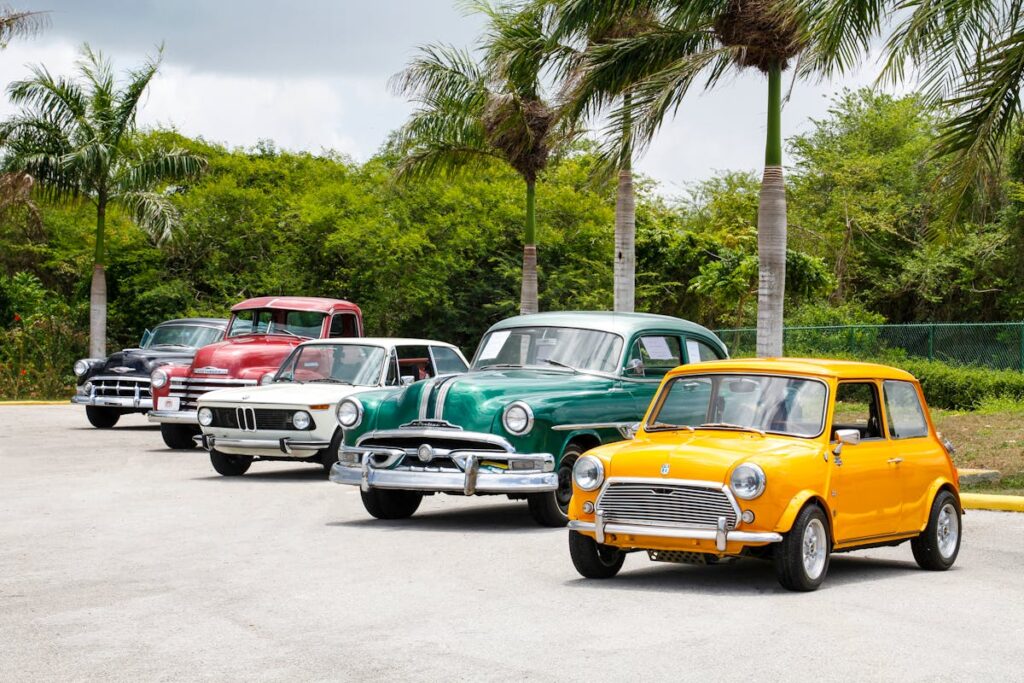As we explore the world of investments, it is intriguing to contemplate the potential lucrative returns that lie within the domain of classic car collection. Indeed, the appreciation of vintage vehicles over time has allowed many an enthusiast to transform their passion into a substantial financial asset. The allure of rare models, the thrill of restoration, and the watchful eye on market trends all contribute to the prospect of significant payoffs. Yet, how does one navigate this enticing path, and what allows a hobbyist to become a successful investor in the classic car market?
Understanding the Classic Car Market
How does one navigate the intricate classic car market? It requires a blend of astute financial acumen, trend awareness, and sensitivity to market demand. Shifting classic car trends can influence the market considerably. For instance, ’80s and ’90s cars are currently experiencing a surge in popularity, which has, in turn, impacted their market value. Diligent investors monitor such trends, factoring them into their purchasing decisions. Understanding market demand is equally vital. Demand can fluctuate based on various elements, including the car’s make, model, and condition. Hence, an analytical approach is essential, one that encompasses a thorough evaluation of market trends and demand. Grasping these intricacies can lead to strategically sound investments in the classic car market.
Key Factors in Choosing Classic Cars
Having gauged the complexities of the classic car market, it is fitting to identify the key factors that influence the choice of classic cars. Primarily, understanding investment trends is essential. This entails studying previous price patterns and predicting future performance. A car whose value has continuously appreciated over the years might be a prudent choice. Additionally, market demand plays a significant role. A car model sought-after by many collectors is more likely to fetch a high price. However, high demand also means increased competition. Finally, the car’s condition and rarity are paramount considerations. A well-maintained, rare model can be a worthy investment. To sum up, selecting a classic car involves a strategic blend of market savvy, trend analysis, and keen attention to detail.
Financing Your Classic Car Hobby
Ever considered the financial implications of your classic car hobby? Financing a classic car requires careful budget planning and understanding various financing options. While your passion might drive your interest, it is important to approach this hobby with financial savvy.
Research shows that different financing options offer various advantages. For instance, personal loans provide flexibility but might come with higher interest rates. On the other hand, auto loans can offer lower rates, though they often require the car to be of a certain age or value.
Understanding your financial limits is also critical. Budget planning enables you to determine how much you can comfortably invest without jeopardizing your financial stability. Consequently, financing your classic car hobby requires a balance between passion and practical financial management.
Restoration: The Hidden Investment
While the allure of classic cars often lies in their historical charm and aesthetic appeal, it is essential to recognize restoration as a significant, often overlooked, financial investment. Restoration techniques not only return these vehicles to their former glory, but can also substantially enhance their market value. Detail-oriented restoration, which includes elements such as professionally reupholstering interiors, meticulous engine work, and precise paint jobs, can transform a rusting relic into a high-demand collector’s item. This process, requiring both financial outlay and time, harbors an underlying investment potential. The capital appreciation of a well-restored classic car can outperform traditional investments. Consequently, patience, skills, and strategic investments in restoration can yield substantial financial returns in the classic car market.

The Role of Car Auctions
Although the restoration process plays an integral role in enhancing the value of classic cars, auctions serve as the primary platform for realizing these investments. Understanding car auction dynamics is essential for potential investors, as it directly impacts the success of their financial returns. Auction bidding strategies vary, and they require a thorough comprehension of the car’s value, keen observation of competitor bidders, and an ability to make swift decisions under pressure. Remember, each car auction presents unique opportunities and challenges, and the bid price should reflect not only the car’s current condition and rarity but also its potential for future appreciation. Hence, careful planning and strategic execution can make a car auction a profitable venture.
Classic Cars Vs Traditional Investments
Comparing classic cars to traditional investments necessitates a thorough understanding of how classic car values are determined. The assessment of risks associated with traditional investments, such as stocks and bonds, is essential to make an informed comparison. In addition, the potential returns of both investment avenues must be weighed to determine the more financially viable option.
Understanding Classic Car Values
To truly comprehend the value of classic cars as an investment, one must first understand the fundamental differences between this and more traditional forms of investment. Classic car valuation is not dictated by the same factors as traditional investments. It doesn’t follow the standard financial indexes; instead, it is largely influenced by market demand, rarity, and the car’s condition. The value can increase considerably over time if the specific model becomes highly sought-after. It’s also important to take into account the emotional value attached to classic cars; they have a nostalgic allure that cannot be quantified, further complicating the valuation process. By understanding these unique factors, investors can make more informed decisions when diversifying their portfolio with classic cars.
Assessing Traditional Investment Risks
Understanding the unique valuation of classic cars provides a clear foundation for analyzing the traditional investment risks associated with them in contrast to standard investments. The risk assessment for classic cars necessitates an understanding of their intrinsic value, rarity, and condition, which often fluctuates based on market trends and collector demand. In contrast, traditional investments like stocks or bonds carry risks tied to market fluctuations, company performance, and economic factors. These investment strategies have different risk profiles: classic cars carry the risk of physical damage or depreciation due to improper maintenance, while traditional investments are susceptible to financial market volatility. Consequently, diversifying a portfolio with both types of investments can help mitigate these risks.
Weighing Potential Returns
While the prospect of investing in classic cars can be enticing due to their unique intrinsic values, it is essential to weigh the potential returns against those of traditional investments. The return potential of classic cars is often less predictable, influenced by factors such as rarity, condition, and market trends. Conversely, traditional investments like stocks or bonds offer more predictable, albeit often lower, returns. An investor’s timeline also plays a significant role. Classic cars typically yield higher returns over a longer investment timeline, thus requiring patience. Traditional investments, on the other hand, can provide quicker, more liquid returns. Consequently, balancing these factors is key when weighing the potential returns of classic cars versus traditional investments.
Managing Risk in Classic Car Investment
In the domain of classic car investments, understanding potential risks and employing effective strategies to mitigate financial losses are fundamental to ensuring a sound and profitable investment. From market volatility to unforeseen maintenance costs, these risks can greatly impact the overall profit margin. Consequently, a thorough risk management approach, backed by meticulous financial analysis and strategic planning, is paramount to safeguard the investment.
Understanding Investment Risks
Although investing in classic cars can be a lucrative venture, it also comes with its own set of risks that investors need to be aware of. One such risk is investment volatility; the value of classic cars can fluctuate greatly due to changes in collector demand, economic downturns, or oversupply of certain models in the market. These market fluctuations can lead to considerable changes in the car’s value, sometimes in a short period of time. Additionally, the condition of the car, authenticity of parts, and rarity can greatly affect the return on investment. Misjudging these factors can lead to financial losses. As a result, understanding these risks is critical to successful classic car investment.
Mitigating Financial Losses
Steering through the potentially choppy waters of classic car investment requires a strategic approach to managing risk and thereby mitigating financial losses. Astute investors employ a dual strategy, utilizing insurance options and closely monitoring market fluctuations. Extensive insurance options are indispensable in protecting against unforeseen damage or theft. Specialty providers offer policies tailored to classic cars, accounting for their unique value and restoration costs. Simultaneously, it is critical to stay abreast of market trends. Market fluctuations can greatly impact a car’s value; understanding these shifts allows investors to make informed decisions on when to buy, hold, or sell. By combining insurance coverage with an analytic eye on the market, investors can effectively mitigate potential losses.
Success Stories: Classic Cars That Paid Off
While many view classic cars as a mere hobby, several astute investors have managed to turn their passion into considerable financial gains. Delving into investment stories, a 1962 Ferrari 250 GTO, bought for $35,000 in 1974, fetched an astounding $38.1 million in 2014. This represents an annualized return of 14.3%, markedly outperforming traditional investments. Another collector’s experience saw a 1971 Plymouth Hemi ’Cuda convertible purchased for $250,000 in 2002, later sold for $2.2 million in 2007, a remarkable 760% return. These examples underline the potential profitability in classic car investments. However, it’s crucial to note that success requires deep knowledge, patience, and an eye for market trends. As with all investments, risks are inherent and must be managed diligently.
Frequently Asked Questions
What Are the Tax Implications of Investing in Classic Cars?
Investing in classic cars may have tax implications. Potential tax benefits could include deductions for maintenance costs. However, depreciation rates also need to be considered, as they may impact the overall return on investment.
How Does Classic Car Insurance Differ From Regular Car Insurance?
Classic car insurance differs from regular insurance primarily regarding valuation. Classic car policies typically offer agreed value coverage, while regular policies offer actual cash value. Collector car coverage also often includes hobby-related benefits.
What Resources Are Available to Learn More About Classic Car Maintenance?
Numerous resources are available for learning classic car maintenance, including online courses and detailed maintenance manuals. These provide extensive information on upkeep, ensuring the longevity of your investment and potential financial gains.
How to Determine the Authenticity of a Classic Car Before Purchasing?
To determine the authenticity of a classic car, conduct thorough research into the car’s history and consult a professional for a detailed vehicle appraisal. This guarantees the vehicle’s legitimacy and true market value.
Can You Make a Living Out of Classic Car Trading?
Yes, classic car trading can be profitable, with savvy investment strategies and understanding of classic car markets. However, success requires thorough knowledge of vehicle authenticity, market trends, and restoration costs to guarantee a positive return on investment.

